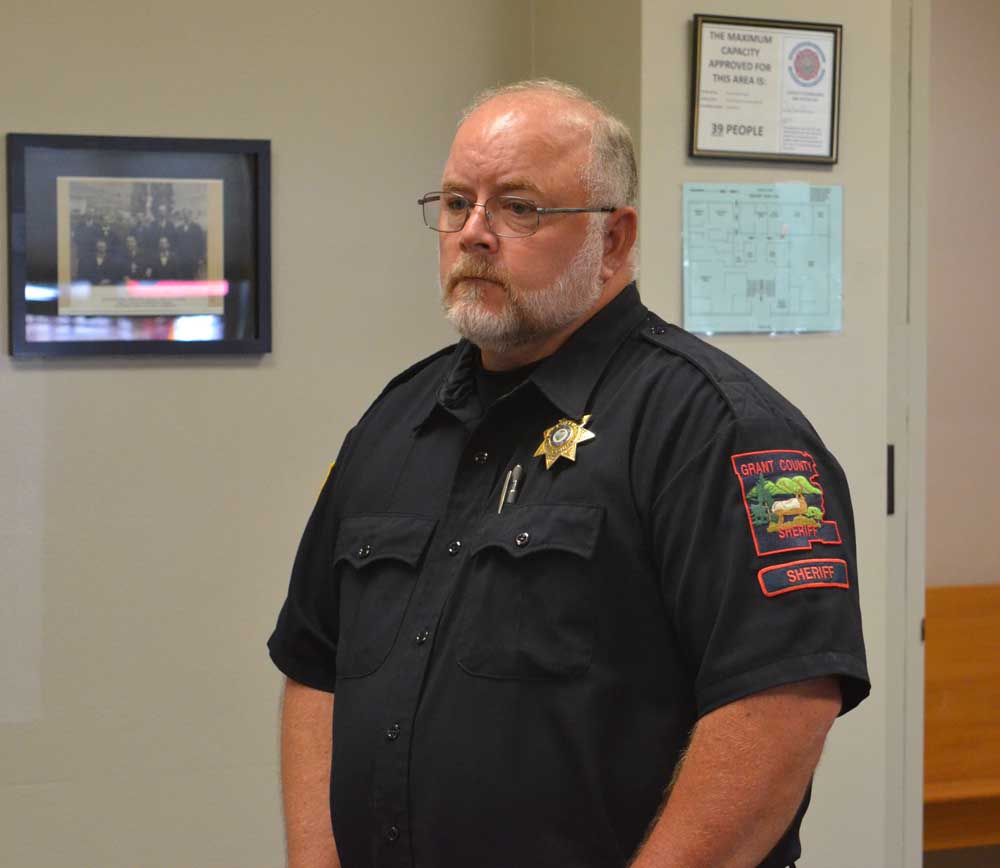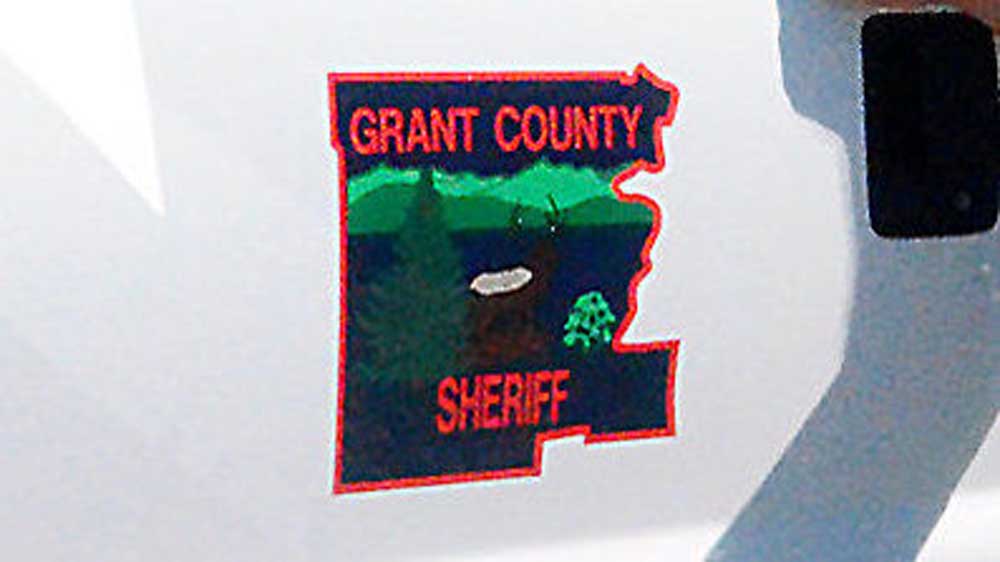Vance Creek cold case victim identified
Published 2:00 pm Tuesday, July 9, 2019

- Grant County Sheriff Glenn Palmer spoke to the county court about the Vance Creek cold case last fall.
The mummified body of a man found in Vance Creek 22 years ago has been identified, thanks to DNA and genealogical evidence and assistance from a popular TV show.
Trending
Long believed to be a homicide victim, the man’s identity remained a mystery ever since Sheriff Glenn Palmer was a John Day police officer.
After he was elected sheriff in 2000, Palmer turned to media announcements and contacted agencies with DNA databases in an attempt to track down the story behind the Vance Creek corpse.
Palmer began working with former Las Vegas Metro Police crime scene investigator Yolanda McClary in November 2018. McClary starred in the popular TV show “Cold Justice” for 47 episodes and three seasons and is now with a new project called “Unknown Doe.”
Trending
Using new DNA evidence and assistance from a genealogist hired through McClary, a full name and date of birth came forward in May, Palmer announced in a July 9 press release.
An out-of-state family was contacted and permission was obtained for a DNA sample from a potential family member. A positive match to DNA from the Vance Creek body was made on July 8, Palmer said.
An inquiry into the Oregon Law Enforcement Data System and the National Crime Information Center turned up a valid Washington County warrant for David Larry Stroh, 51, of Sheridan.
Stroh had been indicted by a grand jury for first-degree sodomy, first-degree sex abuse and second-degree sex abuse. The FBI office in Portland issued a warrant against Stroh in April 1997 for unlawful flight to avoid prosecution.
“I am extremely thankful for the help and assistance of Yolanda McClary and her team of investigators from the private sector,” Palmer said.
Initial discovery
Human remains were initially found in the Vance Creek drainage about a mile and a half west of Highway 395 and south of John Day by Chad Holliday in 1997.
Holliday was gathering cattle on horseback near Fall Mountain in fall 1997 when he spotted what appeared to be part of a human skull.
“I’ve seen most every skull this county has to offer,” he told the Eagle at the time. “There is nothing as big as a human brain.”
He left the skull fragment where he found it and only briefly scanned the area for additional remains. He wasn’t sure he wanted to find any more.
“It was kind of eerie,” he said.
Holliday reported his finding to the sheriff’s office, and the next day he escorted Sheriff Fred Reusser, John Day dentist Curtis Hansford, John Day Police Chief Swede Larson and Cpl. Julie Armistead to the site. Officials took photographs and conducted a grid search until the effort was halted by snowfall.
Hansford initially said he needed to further study the skull fragment to determine if it was human. The sheriff’s office at first assessed the skull as from a bear, but an anthropological exam confirmed it was from a human. By that time, however, winter conditions in the area ended the on-site investigation.
Second discovery
Interest in the case was renewed seven months later when Ted Ferrioli discovered a corpse in the cold rushing waters of Vance Creek. Ferrioli was walking his dog on the weekend of May 2-3, 1998, when he found the remains.
The naked body, missing its head and hands, was found partially buried and immersed in Vance Creek, below a log landing from an old timber sale and about 100 yards from where Holliday had found the skull fragment. It was believed the creek did not run high enough to move the body downstream.
The body was semi-mummified after being in Vance Creek for a time and then frozen through the winter.
The remains were transported to Driskill Memorial Chapel and then sent to the State Medical Examiner’s Office in Portland for additional examination.
An autopsy determined that the deceased white man was 49-73 years old, about 5 feet 7 inches tall and weighed about 225 pounds. The forensic lab determined the man was killed between May and November 1997. No personal items, teeth or hair were found in the area, but the autopsy determined the man had severe atherosclerotic coronary artery disease.
Local investigation
Palmer took over the case in 2000. After gathering all available information and reaching a standstill, he went to the public in 2011 seeking assistance.
The cause of death was a homicide, Palmer said at the time, but he withheld details on the manner of death. The sheriff said the man was either brought to the site and killed or killed somewhere else and dumped there.
A nearby secondary road was likely used by the suspect, Palmer said. The remoteness of the area suggested the perpetrator was a local, but DNA testing had ruled out leads involving missing people. He said he believed the man was from outside the area.
Palmer noted at the time that several leads had been unsubstantiated or disproved. Even psychics had come forward with opinions, he added.
“We’re still trying to find his identity,” Palmer said at the time. “It’s definitely a homicide, but we know that somebody doing this by themselves is highly unlikely.”
The investigation got new life with interest by McClary and her investigative TV show. Palmer advised the county court Nov. 28 that investigating the cold case would increase expenses for the sheriff’s office, including overtime.
“Until we can determine if this person was shot and killed here or shot somewhere else and dumped here, this will be our case until a crime scene of a different origin can be determined,” Palmer said.
These types of investigations are time consuming, he said, and if the sheriff’s office dedicated one or two people solely to this case, other personnel likely would have to carry the rest of the office’s work load.
TV justice
“Cold Justice” is a true crime series produced by Dick Wolf, who created the popular “Law and Order” shows and spinoffs. It was originally broadcast on TNT and then moved to the Oxygen network.
The series initially starred Yolanda McClary, whose career in Las Vegas inspired the character Catherine Willows on the fictional TV show “CSI,” and former Harris County, Texas, prosecutor Kelly Siegler.
“Cold Justice” kicked off in September 2013 and ran for two seasons. It rebooted in July 2017 and remains on the air. The show’s realism extends to its success rate, as McClary and Siegler brought evidence to prosecutors and requested that cold cases be reopened.
As of April 2018, the “Cold Justice” team helped to generate 35 arrests and 18 convictions, in addition to four confessions, three guilty pleas and three murder convictions.
In October 2018, the “Cold Justice” team explored the real events that inspired Martin McDonagh’s 2017 movie “Three Billboards Outside Ebbing, Missouri,” which earned seven Oscar nominations.
McClary left “Cold Justice” and moved on to a new project in 2017 called “Unknown Doe.” People can send information to the show by emailing contact@unknowndoe.com.
New leads
Prior to last fall, the Grant County Sheriff’s Office worked with families missing relatives, the Oregon State Police Homicide Investigation Tracking System, the Oregon State Medical Examiner’s Office, the Oregon Law Enforcement Data Systems, the National Crime Information Center, the National Missing and Unidentified Persons System and the University of North Texas, where a DNA database is collected and stored.
Palmer said he reached out to at least two private sector labs in an attempt to compare DNA from the Vance Creek body with the FBI’s Combined DNA Index System, which includes DNA from cold cases and convicted offenders.
“However, until most recently and thankfully with the help and not only many man-hours put in by McClary and her team, the financial obligation this organization put into this is well into the thousands and thousands of dollars,” Palmer said.
Last November, Dr. Nici Vance, a forensic anthropologist at the Oregon State Police, joined the state Medical Examiner’s Office in authorizing McClary and a private lab to use DNA evidence from the Vance Creek remains.
Palmer said he and McClary spent several months tracking the DNA with assistance from a genealogist.
“Several leads and family histories were compared, and over a period of time and work several people were excluded,” Palmer said.
They zeroed in on a full name and birth date in May as a prospective hit. A potential family member was found in Nebraska, who requested anonymity and was apprehensive about providing a DNA sample.
A DNA match was made, and the name was put through the state and national crime databases. A grand jury indictment and unlawful flight warrant for the man was then found.
“We believe that Mr. Stroh is a victim of homicidal violence, and this case is still being worked as an active homicide,” Palmer said. “We have made fairly significant steps in the identity of this person, and with this we would hope that someone with information would come forward.”
Palmer encouraged anyone with a missing family member or relative to submit their DNA to a private lab for comparison against a private sector database. They can also contact their local sheriff, who can arrange to take a DNA sample and compare it with government databases, he said.








